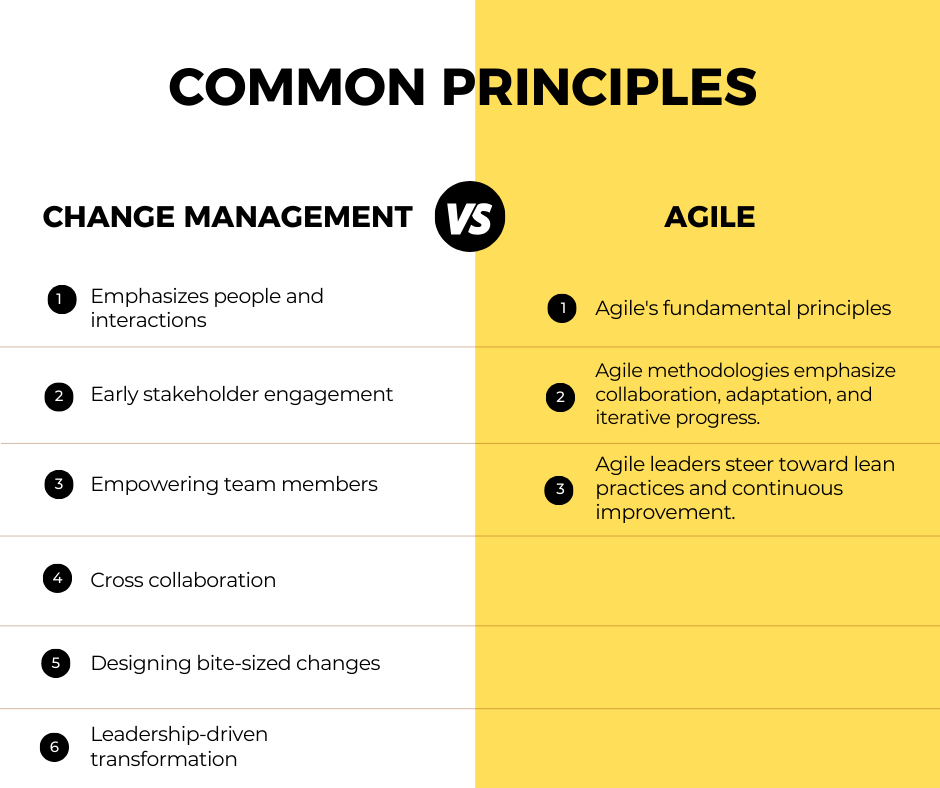In the ever-evolving landscape of project management and software development, Agile has transcended its origins and become a versatile approach applied not only in software development but also in project and operations management. As Agile gains popularity, change practitioners are increasingly aligning their strategies to support Agile environments. This article explores the fundamental principles of Agile and how they dovetail with change management, highlighting the valuable lessons we can draw from Agile’s evolution.
The Convergence of Agile and Change Management
Agile’s Expansion Beyond Software Development
Agile, initially conceived for software development, has expanded its horizons to encompass project management and operations. The principles that underpin Agile, outlined in the Agile Manifesto, have become a guiding light for many across various industries. With methodologies like Scrum, Kanban, and Refactoring, Agile can be applied at different levels, from project teams to program and portfolio management.
Change Management and Agile: A Harmonious Union
Having personally gone through the Scaled Agile certification process, I was struck by how many fundamental change management principles are deeply embedded within Agile. In my multi-day training course, case studies, and examination, I realized that many concepts that are considered common sense in change management are sometimes perceived as ‘new’ for technical leads or project managers in an Agile context. Agile inherently incorporates principles that change managers have advocated for a long time.

Foundational Change Management Principles in Agile
1. Individual Interactions Over Processes and Tools
In technology-driven environments, technical professionals are highly regarded for their problem-solving skills. The typical response to issues or improvement opportunities is to seek technical solutions. However, the Agile Manifesto focuses on people and interactions. It stresses that teams perform at their best when they maintain constant interaction to ensure effective communication, clarity, and understanding of the work at hand. For instance, a study by McKinsey found that projects with strong team interactions deliver on their objectives 95% of the time, while those lacking strong collaboration only succeed 50% of the time. This principle resonates strongly with change managers, who have consistently advocated for a focus on people and behaviors as central to change management success.
2. Early Involvement of Stakeholders
Agile projects move swiftly, making it crucial to involve stakeholders early in the project development lifecycle. Early engagement ensures clear alignment, fosters relationships among team members, and helps draw out assumptions and set expectations. For example, a survey conducted by Prosci revealed that projects involving early stakeholder engagement had a 74% success rate, compared to only 31% for projects that did not engage stakeholders early. This aligns with change management practices, which emphasize engaging stakeholders early to secure buy-in and alignment. Beyond formal communication, it encourages open dialogue and the testing of assumptions for early clarity across the project team.
3. Empowering Team Members
Traditionally, project managers held the reins in decision-making across all aspects of a project, including solution features and task allocation. Agile challenges this command-and-control model by empowering teams to make these decisions. Effective Agile teams are often self-organized, with project managers transitioning to coaching and enabling roles. For example, a study by Gallup found that empowered teams have 21% higher productivity and 28% less absenteeism. This empowerment aligns with the core principles of change management, which emphasize team dynamics and employee empowerment as essential for team development and engagement.
4. Cross Collaboration
Agile projects thrive on the diverse collaboration of team members from different disciplines and departments. This diversity of thought leads to more innovative ideas, as it brings different perspectives to problem-solving. For example, a report by Deloitte found that organizations with cross-functional teams are 1.7 times more likely to be leaders in innovation. Agile practices, such as cross-team daily stand-ups, release planning, and retrospectives, require different disciplines to come together and contribute to the project. Change management has long focused on breaking down silos and promoting collaborative behaviors, using workshops, communication, campaigns, and leadership influence to foster the right culture and behaviors for successful outcomes.
5. Designing Bite-Sized Changes
One of Agile’s fundamental principles is the idea that, instead of launching large, all-encompassing changes, it’s better to break them down into smaller, iterative pieces. This approach allows for continuous learning and improvement and mitigates the risk of major failures. Change management aligns with this principle by assessing the change capability and capacity of impacted audience groups. For instance, a case study by Prosci showed that an organization that implemented small, incremental changes had a 20% higher user adoption rate compared to organizations that introduced major changes all at once. Smaller, bite-sized changes are easier for users to accept, preventing change fatigue and disruptions to business as usual.
6. Leadership
Agile explicitly acknowledges that organizational managers and leaders bear the ultimate responsibility for the adoption, success, and continuous improvement of lean practices. Leaders must steer the organization towards agile and lean behaviors, role-model the right behaviors, create an environment conducive to team success, and ensure continuous team learning. Leadership plays a central role in change management, driving transformation, and cannot be delegated.
Agile and Change Management in Action: Best Practices
As we’ve explored the evolving landscape of project management and software development, it’s clear that Agile is no longer confined to its origins. It has become a versatile approach, expanding beyond software development to encompass project and operations management. With Agile’s growing popularity, change practitioners are increasingly aligning their strategies to support Agile environments. In this article, we’ve delved into the fundamental principles of Agile and how they seamlessly integrate with change management. Now, let’s take a closer look at real-world best practices with actionable advice and examples that illustrate the power of combining Agile and change management in practical scenarios.
What’s more, we provide actionable advice that you can apply directly to your projects. Whether you’re leading a software development team or managing a complex change initiative, the best practices we showcase can be tailored to suit your specific needs. From effective stakeholder engagement techniques to strategies for empowering your teams, you’ll find practical steps to ensure your projects thrive. For example, implementing daily stand-up meetings for cross-functional teams can significantly enhance collaboration and idea exchange within your projects.
By incorporating these best practices, organizations can harness the full potential of Agile and change management to adapt, innovate, and achieve exceptional results. With expert guidance and empirical evidence of successful benchmarks, you can confidently implement these principles in your projects, ensuring success in even the most complex and dynamic environments.
The synergy between Agile and change management is undeniable. Agile principles, which emphasize people, collaboration, empowerment, and adaptability, align remarkably well with the foundational principles of change management. Whether transitioning from a technical background to Agile or integrating Agile into change management practices, it’s essential to recognize that Agile is more about mindset and principles than specific technicalities. By embracing these shared principles, change management and Agile become a harmonious partnership, working together to drive successful transformations and project outcomes.
To learn more about how The Change Compass can help you bridge the gap between Agile and change management, book a weekly demo with us.






